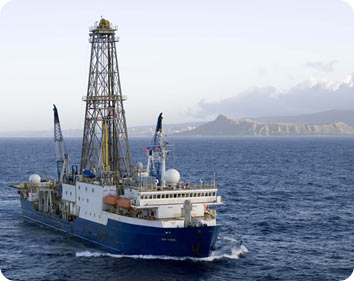To understand the history of the oceans, you have to go deep -- not just deep below the surface, but deep below the ocean floor. Over millions of years, sand, silt, volcanic ash, dead plants and animals, and other material settles to the bottom, forming a geological layer cake -- thin bands that record the history of the oceans and the entire planet.
 The JOIDES Resolution departing Honolulu, Hawaii. Credit: Integrated Ocean Drilling Program, William Crawford
The JOIDES Resolution departing Honolulu, Hawaii. Credit: Integrated Ocean Drilling Program, William CrawfordTo probe these layers, marine scientists use a technique known as deep-ocean coring. They basically plunge a tube into the ocean floor, letting it dig deep into the sediments that have piled up there. The tube contains a plastic liner to encase the sediments. When the tube has bored as far down as it can, a cap closes over the end, then the tube is pulled back aboard ship.
One technique simply uses gravity to get the job done. The core tube is released when it’s well above the ocean floor, then it falls and plunges into the sediments. This technique can drill up to a few feet deep. Since sediments in the deep ocean pile up at about a centimeter every thousand years, these cores can probe tens of thousands of years into the past.
For deeper cores, scientists use the same technology as oil rigs. A ship known as JOIDES Resolution, for example, can drill several thousand feet into the sediments -- and tens of millions of years into the past.
Once the cores are aboard ship, though, the work is just beginning -- the work of deciphering the history of the oceans from a geological layer cake. More about the next steps on our next program.

